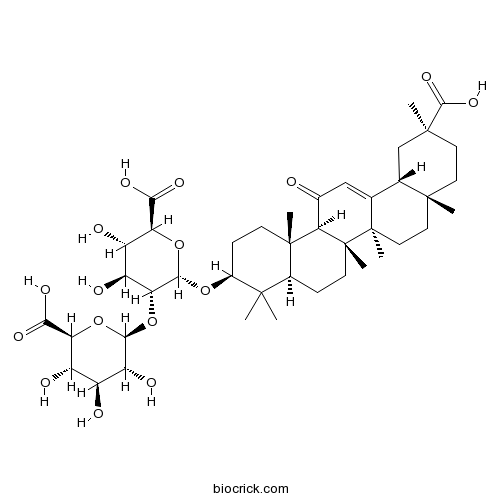A triterpenoid saponin that is the glucosiduronide derivative of 3β-hydroxy-11-oxoolean-12-en-30-oic acid.
InChI=1S/C42H62O16/c1-37(2)21-8-11-42(7)31(20(43)16-18-19-17-39(4,36(53)54)13-12-38(19,3)14-15-41(18,42)6)40(21,5)10-9-22(37)55-35-30(26(47)25(46)29(57-35)33(51)52)58-34-27(48)23(44)24(45)28(56-34)32(49)50/h16,19,21-31,34-35,44-48H,8-15,17H2,1-7H3,(H,49,50)(H,51,52)(H,53,54)/t19-,21-,22-,23-,24-,25-,26-,27+,28-,29-,30+,31+,34-,35-,38+,39-,40-,41+,42+/m0/s1
Glycyrrhizic acid has immunoregulatory function,it(up to 100 mg/ml) can inhibit interleukin-6 and elevate interleukin-10 production in lipopolysaccharide-activated macrophages, and significantly inhibit proliferation of spleen lymphocytes; rectally administered glycyrrhizic acid has significant protective effects against TNBS-induced colitis in rats.[1]
Glycyrrhizic acid and 18β-glycyrrhetinic acid may provide an anti-inflammatory effect by attenuating the generation of excessive NO, PGE(2), and ROS and by suppressing the expression of pro-inflammatory genes through the inhibition of NF-κB and PI3K activity, might serve as potential agents for the treatment of inflammatory-mediated diseases.[2]
Glycyrrhizic acid offers radioprotection by scavenging free radicals.[3]
Glycyrrhizic acid is the antiviral component of Glycyrrhiza uralensis Fisch. against coxsackievirus A16 and enterovirus 71 of hand foot and mouth disease with distinct mechanisms.[4]
English website: Glycyrrhizic acid
Japanese website: Glycyrrhizic acid
Chinese website: Glycyrrhizic acid
[1] Liu Y, Xiang J, Liu M, et al. Lat Am J Pharm , 2011, 63(3):439-46.
[2] Wang CY, Kao TC, Lo WH, et al.Journal of Agricultural & food Chemistry, 2011, 59(14):7726-33.
[3] Wang D, Pang Y X, Wang W Q, et al. Biochem Syst Ecol, 2013, 50(7):93-100.
[4] Wang J, Chen X, Wei W, et al. J Ethnopharmacol, 2013, 147(1):114-21.
[5] Miao H, Qian Y, Xue L, et al. Primary Journal of Chinese Materia Medica, 2000,(5):17-18.



